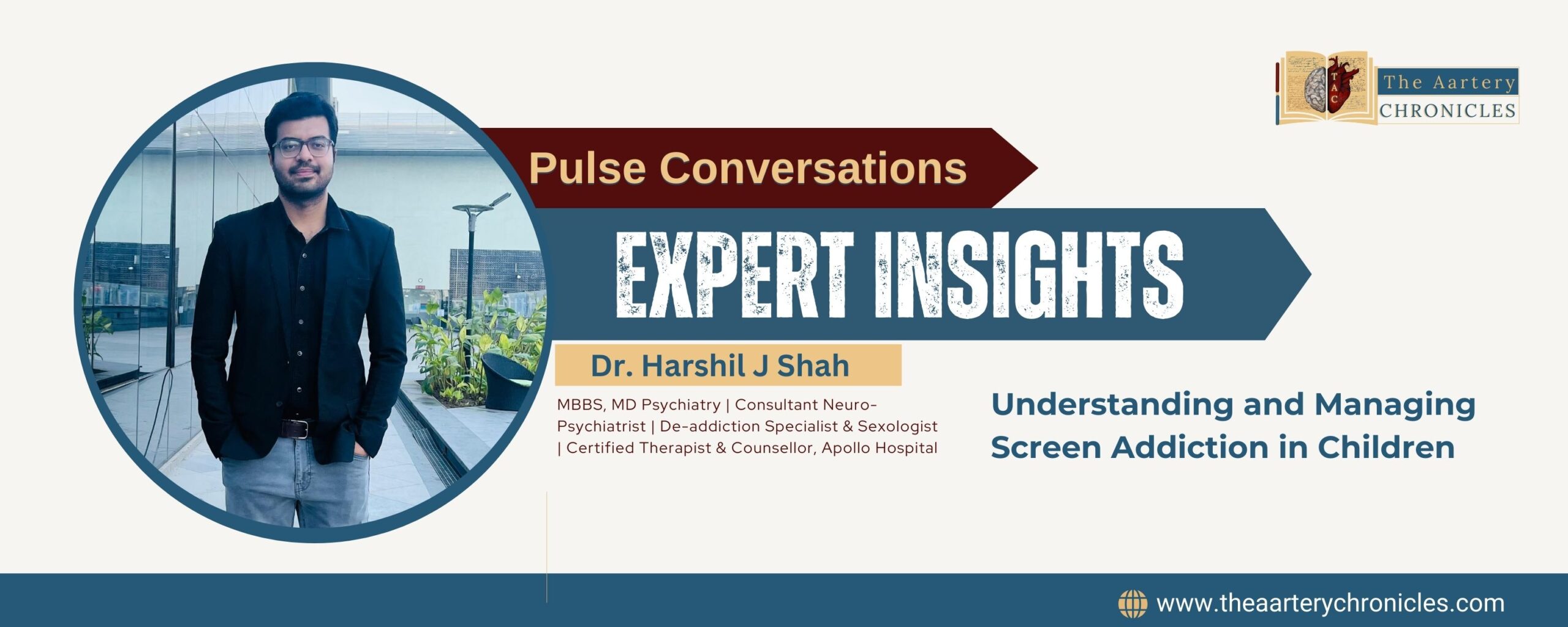

Expert Insights – Dr. Harshil Shah: Managing Screen Addiction in Kids
Overview
In today’s increasingly digital world, screen addiction is becoming a growing concern, especially among children. Dr. Harshil J Shah shares his insights on how to recognize and manage screen addiction in children and offers strategies for parents to help guide their children toward healthier technology use.
In a conversation with The Aartery Chronicles, Dr. Harshil J Shah, (MBBS, MD Psychiatry) an esteemed psychiatrist affiliated with Apollo Hospitals, delves into the importance of Understanding and Managing Screen Addiction in Children
Recognizing the Signs of Screen Addiction
Dr. Shah emphasizes the importance of identifying when normal phone use turns into an addiction. He explains that there are no strict criteria regarding the number of hours spent on devices to classify addiction. Instead, the focus should be on how phone usage impacts a child’s daily life.
Key signs of screen addiction include:
- Restlessness
- Irritability
- Anxiousness
- Sleep disturbance
- Cravings for their device when it’s taken away.
Children might struggle to function without their phones, showing withdrawal symptoms similar to those experienced with substance addiction.
“If a child is using a phone for 5-6 hours a day, avoiding social interaction, experiencing declining academic performance, or becoming irritable when denied access to their phone, these are clear indicators of a screen addiction,” says Dr. Shah.
The Role of Dopamine in Screen Addiction
Dr. Shah highlights the role of dopamine in reinforcing addictive behavior. When children play games or receive social media notifications, they experience a dopamine kick, which gives them a sense of pleasure or accomplishment. Whether it’s completing a level in a game or receiving likes on a post, this reward system fuels addiction.
He explains that children look forward to rewards, and the surge of dopamine drives them to keep returning for more. This dopamine-fueled response makes screen time addictive, as kids start linking their devices with enjoyment and instant gratification.
Breaking the Cycle: Effective Parenting Strategies
Addressing screen addiction in children requires a multi-pronged approach. Dr. Shah emphasizes that parental involvement is key to breaking unhealthy patterns and setting boundaries. Here are some effective strategies he recommends:
1. Breaking the Tantrum Cycle
Many parents believe that giving the phone when a child throws a tantrum is the quickest solution to calm them down. Dr. Shah challenges this mindset:
“Even if a child is throwing tantrums or becoming irritable, it’s important not to give in. The child may throw a tantrum for 15 minutes or even half an hour, but in the long term, you’re allowing them to develop an addiction,” he explains.
The lack of maturity and awareness at the time of the abuse makes it difficult for children to express their feelings or seek help. This delayed reaction to trauma is a serious issue, requiring vigilance and support from parents and mental health professionals.
2. Setting Clear Time Limits
Dr. Shah recommends using parental control tools such as screen time limits or child locks to regulate phone use. However, he also notes that many children become savvy at bypassing these controls.
“Even if a child is throwing tantrums or becoming irritable, it’s important not to give in. The child may throw a tantrum for 15 minutes or even half an hour, but in the long term, you’re allowing them to develop an addiction,” he explains.
Parents should establish a specific time window for phone use, such as one or two hours a day. Keeping the phone out of the child’s reach outside of that allotted time reinforces a healthy habit.
3. Employing Positive Reinforcement
One of the most effective ways to curb addiction is through positive reinforcement. Dr. Shah encourages parents to link screen time with productive activities like studying or engaging in physical exercise.
“If a child studies for a certain number of hours, say 2-3 hours, parents can grant a fixed amount of screen time as a reward. This reinforces the positive behavior while keeping phone use in check,” he explains.
By using screen time as a reward for positive actions, parents can encourage their children to prioritize healthy activities while still enjoying their devices in moderation.
4. Encouraging Physical Activity and Hobbies
Dr. Shah suggests substituting screen time with physical activities to help children develop healthier habits. Enrolling kids in structured activities such as cricket, football, or other sports can provide a constructive outlet for their energy.
“Physical sports not only boost mental health but can also replace the dopamine-driven pleasure children seek from their devices,” Dr. Shah advises.
Having hobbies and engaging in sports helps balance their lifestyle and reduce dependence on screens.
Conclusion
Screen addiction in children is a growing concern, but with the right strategies, it can be managed effectively. Dr. Harshil J Shah emphasizes that by setting clear boundaries, using positive reinforcement, and encouraging physical activities, parents can help their children navigate the digital world responsibly. Ultimately, it’s about creating a balanced relationship with technology that fosters both mental and physical well-being.









